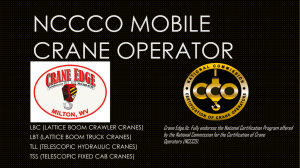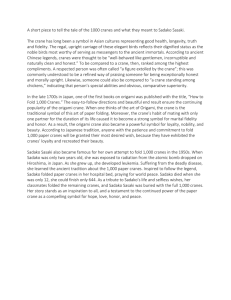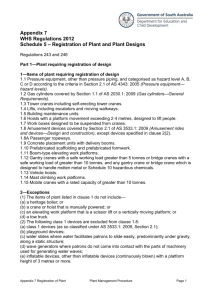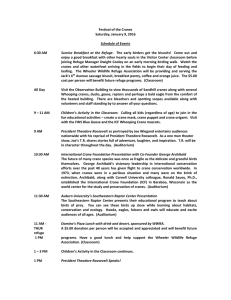Sandhill Crane Roost Site Characteristics in the North Platte River... Author(s): Martin J. Folk and Thomas C. Tacha
advertisement
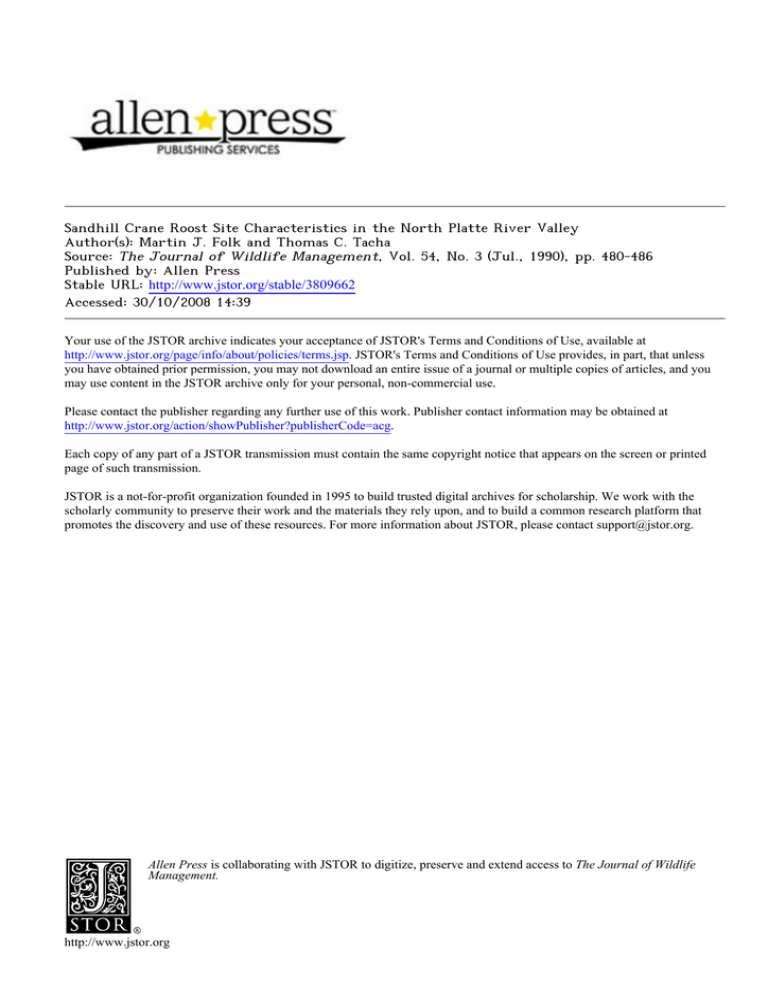
Sandhill Crane Roost Site Characteristics in the North Platte River Valley Author(s): Martin J. Folk and Thomas C. Tacha Source: The Journal of Wildlife Management, Vol. 54, No. 3 (Jul., 1990), pp. 480-486 Published by: Allen Press Stable URL: http://www.jstor.org/stable/3809662 Accessed: 30/10/2008 14:39 Your use of the JSTOR archive indicates your acceptance of JSTOR's Terms and Conditions of Use, available at http://www.jstor.org/page/info/about/policies/terms.jsp. JSTOR's Terms and Conditions of Use provides, in part, that unless you have obtained prior permission, you may not download an entire issue of a journal or multiple copies of articles, and you may use content in the JSTOR archive only for your personal, non-commercial use. Please contact the publisher regarding any further use of this work. Publisher contact information may be obtained at http://www.jstor.org/action/showPublisher?publisherCode=acg. Each copy of any part of a JSTOR transmission must contain the same copyright notice that appears on the screen or printed page of such transmission. JSTOR is a not-for-profit organization founded in 1995 to build trusted digital archives for scholarship. We work with the scholarly community to preserve their work and the materials they rely upon, and to build a common research platform that promotes the discovery and use of these resources. For more information about JSTOR, please contact support@jstor.org. Allen Press is collaborating with JSTOR to digitize, preserve and extend access to The Journal of Wildlife Management. http://www.jstor.org IN THE SANDHILL CRANEROOSTSITECHARACTERISTICS NORTHPLATTERIVERVALLEY andDepartmentof Zoology,SouthernIllinoisUniversity,Carbondale, MARTIN ResearchLaboratory J. FOLK,CooperativeWildlife IL62901 THOMASC. TACHA,'CooperativeWildlifeResearch Laboratoryand Departmentof Zoology, Southern IllinoisUniversity, Carbondale,IL62901 Abstract: We documented sandhill crane (Grus canadensis) roost site characteristicsin the North Platte River Valley (NPRV) of Nebraska in riverine and semipermanent palustrine wetlands from late February through mid-April in 1988 and 1989. Crane roost sites in the river were located closer to visual obstructions, in narrower channels, and in a wider range of water depths than determined previously in the Platte River. Cranes roosted in semipermanent wetlands where widths were >12 m, water depths were 5.0-24.4 cm, and distance to shore was >1 m. Based on the estimated peak number of sandhill cranes and roosting capacity estimates, availability of roosting habitat was not limiting use of the NPRV by cranes. North Platte river flows should be maintained to provide channel widths -48 m and water depths '21 cm for roosting cranes. Temporary (wet meadow) and semipermanent palustrine wetlands adjacent to the river should be preserved to provide important diurnal and nocturnal crane habitat. J. WILDL. MANAGE.54(3):480-486 I The North Platte and Platte River valleys of Nebraska are the primary spring staging areas for the midcontinental population of sandhill cranes (Benning and Johnson 1987). Cranes are dependent upon these valleys to provide high energy foods (especially corn) necessary to accumulate lipid reserves for use in nesting areas (Krapu et al. 1985, Tacha et al. 1987). Loss of grasslands and wetlands to agricultural and commercial development has altered staging habitat of sandhill cranes (Lewis et al. 1977, Currier and Ziewitz 1987). Flow reductions in the rivers allowed encroachment of woody vegetation on sandbars used by cranes for roosting. Current management of crane roosting habitat includes maintenance of water flows and costly mechanical removal of woody vegetation (Lingle 1982). Iverson et al. (1987) found up to 67,500 (45% of total) cranes using off-river temporary and semipermanent wetland roost sites in the North Platte River Valley (NPRV) and recommended the preservation of existing sites and development of additional off-river roost sites. However, no studies of roost site selection have been conducted in the NPRV. Our objectives were to determine factors associated with crane use and selection of river and adjacent I Present address: Caesar Kleberg Wildlife Research Institute, Texas A&I University, Campus Box 218, Kingsville,TX 78363. wetland roosts and to estimate the roosting capacity of the NPRV. We thank G. A. Wingfield of the Nebraska Game and Parks Commission and P. McDonald of the U.S. Fish and Wildlife Service (USFWS) for providing valuable assistance in Nebraska. Landowners in the NPRV granted access to their property. P. A. Vohs and A. Woolf reviewed the manuscript. This study was funded by USFWS Purchase Orders 64412-00302-88 and 64412-8900026 and the Cooperative Wildlife Research Laboratory, Southern Illinois University at Carbondale (SIUC). Additional support was obtained from the Department of Zoology and the Graduate School at SIUC. STUDY AREA The study area encompassed 260 km2 of the valley formed by the North and South Platte rivers between Sutherland and North Platte, Nebraska (Iverson et al. 1987:Fig. 1). This area has been described previously (Iverson et al. 1987, Krapu et al. 1987, Folk 1989). Semipermanent (unconsolidated mud bottom) and temporary palustrine wetlands (Cowardin et al. 1979) were located in grassland pastures where vegetation height was limited by grazing and haying. Light snow and rain helped maintain temporary wetland water levels in spring 1988. Temporary wetlands held no water in spring 1989; no appreciable winter snow accumulated to provide initial water, and only light snow fell during staging. Some semiper- 480 J. Wildl. Manage. 54(3):1990 manent wetlands went dry in 1989. The North and South Platte rivers and Birdwood Creek were permanent riverine wetlands; the South Platte River was not used by roosting cranes (Iverson et al. 1987, Folk 1989). The North Platte River between Sutherland and North Platte was designated by the USFWS in 1987 as Resource Category 1 for sandhill cranes (U.S. Dep. Inter. 1987). Category 1 areas are of unique and irreplaceable value, with a goal of no habitat loss. METHODS Roost Site Factors of 2 river areas Sampling Design.-Each served as sampling units for initial analyses of roost site selection characteristics (variables). The 2 river areas formed a continuous 3.2-km stretch of channel downstream from the bridge located north of Hershey, Nebraska. Nine semipermanent wetlands (0.1-3.8 ha) used for roosting served as sampling units and were located 1.62.4 km north and 7.2-8.8 km east of Hershey (Iverson et al. 1987:Fig. 1). Areas used by cranes for roosting within each river or semipermanent wetland sampling unit were delineated on aerial photographs; roost and nonroost areas within sampling units served as sampling subunits. Roosts were mapped at night with the aid of a 3 x night-vision scope. We randomly selected sampling points for measuring habitat characteristics within sampling subunits by using a numbered grid overlay on aerial photos and a random numbers table following methods of Soine (1982) and Haley (1983). In 1988, >6 sampling points were selected each week in subunits of the river and 1 semipermanent wetland. Water depth, distance to visual obstruction (obstruction >1 m high), and unobstructed river channel (i.e., channel bank to bank or between visual obstructions), and wetland widths (min. distance across wetland) were measured at each point. Mud depth and average substrate slope were measured following methods of Soine (1982) and Folk (1989: 8-9) when water depths were suitable (<35.6 cm) for crane use (Armbruster and Farmer 1982). Distances to potential human disturbance factors were measured when factors were present within distances that could affect crane roosting (Armbruster and Farmer 1982). Multiple regression analyses of habitat characteristics on crane roost use in 1988 indicated CRANE ROOST SITES * Folk and Tacha 481 slope was not associated (P > 0.10) with roost site selection in the river or semipermanent wetland. Thus, only water and mud depth, unobstructed width, and distance to nearest shore were sampled in subunits of 8 semipermanent wetlands during spring 1989 to increase sample size. Collective predictability of roost site selection criteria for the river (based on 1988 data) was tested in 1989 using night aerial infrared photography from the peak of staging (20 Mar based on weekly surveys [Folk 1989]) and data from a river habitat inventory. This inventory was conducted during the 1989 spring staging period in the 26 km of the North Platte River from the Sutherland bridge to 5.2 km upstream from the Highway 83 bridge at North Platte. Transects perpendicular to the water current were established at 50-m intervals in all channels > 48 m wide (cranes were not observed roosting in narrower channels in 1988). Within each transect, water depth was measured at 4-m intervals within a zone 4 m from each side of the nearest visual obstructions (cranes were not observed roosting closer than 4 m to an obstruction in 1988). Transects were not measured when they fell within 400 m of a bridge (Armbruster and Farmer 1982). Sampling points that met minimum water depth, channel width, and distance to obstruction requirements (from 1988 criteria) for crane roosting were plotted on aerial photographs from the Agricultural Stabilization and Conservation Service (ASCS); polygons were drawn around the perimeter of groups of contiguous plotted points to delineate potential roosts. Potential roosts were then compared to actual roosts as shown on aerial infrared photography of the river. A subset of 16.7 km of river channels (Folk 1989:49) for which photographs of roosting cranes were available was used for visual comparisons with predicted crane roosts. River channels and crane flocks within the river were outlined on acetate sheets placed over the night photographs. These overlays were then enlarged to match the scale of the ASCS photographs where predicted roosts were drawn. Visual comparison of predicted versus actual roost areas clearly indicated that water depth and channel width criteria from 1988 analyses were overly restrictive. Data from the 1989 habitat inventory and infrared photography were then used to reanalyze criteria for channel width and water depth. Channel widths <48 m were J. Wildl. Manage. 54(3):1990 CRANEROOSTSITES* Folk and Tacha 482 10-A. DISTANCE TOOBSTRUCTION (m) 81 = . R 0roost - *nonroost . U - 10 1.- 7l -a- in regression analyses. The initial model for the river, based on 1989 data, included water depth, distance to visual obstruction, substrate slope, unobstructed width, and the interactions between these variables. The initial model for the semipermanent wetland studies using 1989 data included water depth, mud depth, unobstructed width, distance to shore, and associated interactions. Each model was run and rerun removing nonsignificant (P > 0.10) independent variables until all remaining independent variables were significant 1210- B. CHANNEL WIDTH(Nm) -,I U. 6- I,d|| 0 20 H a CgC. 40 60 a 8010012 m f 0 140 160 180 WATER DEPTh(cm) (P < 0.10). We used ANOVA to determine if roost characteristics (dependent variables) varied (P < 0.05) among weeks (independent variable) during 1988. Bar charts were prepared showing percentage distributions of samples (availability) and percentage distributions of samples where cranes roosted (use). These were prepared for significant (P < 0.10) variables (e.g., cm of water depth; Fig. 1) from final 1989 analyses of data from the river and semipermanent wetlands. Chi-square tests were used to determine differences in the ratio of use versus availability among levels of each variable (Neu et al. 1974). When a significant (P < 0.05) difference was present, groups of variable levels showing the highest use were considered optimum, levels of less use were considered suboptimum, and levels with no use were considered unusable. Roosting Capacity River roost criteria were used to plot potential roost sites (polygons) on aerial photographs of the North Platte River from the Sutherland bridge to 5.2 km upstream from the Highway 83 bridge at North Platte. Total potential optimum and suboptimum roost areas were used to predict a range of carrying capacity. We plotted optimum roost sites and used a Platte River,1988-89. Measurementsare from 176 sampling points (A),444 transects (B), and 3,062 samplingpoints (C). planimeter to estimate the area of optimum habitat. Roosting capacity of optimum habitat was not considered in the spring 1989 river habitat the product of this total potential roost area and inventory, but were scaled from aerial photo- an average maximum density of roosting cranes, graphs at 50-m intervals where transects oc- obtained from the peak period of crane use in curred and were included in analyses of 1989 1988 (Folk 1989). Roosting capacity of the subdata. optimum component was the product of subopAnalyses. Two-group t-tests were used for timum area and one-half the density of cranes used for the optimum component. Half density simple comparisons of habitat characteristics, and multiple regression was used to compare was selected subjectively to reflect the assumption that as habitat quality declined from opmultiple habitat characteristics (independent timum to unusable, the number of roosting variables) for roost versus nonroost sites (dependent variable). We included significant factors cranes declined. This estimate of carrying ca(P < 0.05) from t-tests as independent variables pacity was conservative because it did not in- z 22- CRANEROOSTSITES* Folk and Tacha J. Wildl. Manage. 54(3):1990 483 Table1. Multipleregressionanalyses for roost and nonroostsites of sandhillcranes in riverineand semipermanentwetlands in the NorthPlatte RiverValleyduringspring1988 and 1989. Onlysignificant(P < 0.05) variablesare listed. df Independent variablea R2 F P River 4, 171 0.48 39.10 0.0001 OBST WIDTH OBST x WATER WIDTH x WATER Semipermanentwetland WIDTH x SHORE SHORE WIDTH WATER x WIDTH x SHORE 1 1 1 I 7, 225 1 1 1 1 0.08 0.04 0.02 0.01 0.16 0.07 0.06 0.05 0.03 14.58 12.35 5.82 4.04 6.11 19.34 16.04 13.79 9.27 0.0002 0.0006 0.0169 0.0459 0.0001 0.0001 0.0001 0.0003 0.0026 WATER 1 0.03 8.63 0.0036 WATER x SHORE WATER x WIDTH 1 1 0.03 0.02 7.40 5.71 0.0070 0.0177 a WIDTH = unobstructed width (m) of river channel or wetland, OBST = distance (m) to visual obstruction, WATER = depth (cm) of water, SHORE = distance (m) to nearest shore. clude all channels <48 m where cranes could roost. RESULTS Roost Site Factors River. -Water depth, distance to obstruction, substrate slope, and unobstructed width were significantly different between roost and nonroost sites of the river (Folk 1989:19). Distance to obstruction, unobstructed width, the interaction of distance to obstruction with water depth, and the interaction of unobstructed width with water depth (Table 1) explained 48% of the variation in roost site selection. Substrate slope was not retained (P > 0.10) in the model. River water levels fluctuated 10 cm between 19 March and 12 April 1988 (Folk 1989), but none of the river roost characteristics varied (P > 0.09 for all F-tests) among weeks. Water levels decreased 12 cm from 10 to 12 March 1989 and fluctuated 5 cm between 13 March and 13 April. We assumed these fluctuations in river levels in 1989 (smaller than in 1988 after 12 Mar) had little effect on crane roost site selection. There were 60 sampling points for measuring distance to obstruction within roosts; 52% were >25 m, and 48% were 4-25 m from a visual obstruction (Fig. 1A). Use versus availability among distance categories <3, 4-25, and >25 m was different (x2 = 45.50, 2 df, P = 0.001). Cranes roosted in the river as close as 4 m to an obstruction, but preferred distances >25 m. There were 261 channel widths measured where cranes roosted; 82% were >48 m, and 18% were 16-47 m (Fig. 1B). Use versus availability of channel widths <48 m and > 48 m was different (x2 = 162.10, 1 df, P = 0.0001). Cranes roosted in channels > 16 m in width, but preferred channels >48 m wide. Eighty-six percent of 1,598 points within cranes roosts were in depths <21 cm, and 14% were in depths from 21.1 to 35.5 cm (Fig. 1C). Use versus availability of water depths '21 cm was different (x2 = 545.58, 1 df, P = 0.0001) from use of depths >21 cm. Water depths <35.5 cm were used; depths ?<21 cm were preferred. depth, Semipermanent Wetlands.-Water mud depth, unobstructed width, and distance to nearest shore were different between roost and nonroost sites of the semipermanent wetlands (Folk 1989:29). Water depth, wetland width, distance to shore, and their interactions (Table 1) explained only 16% of the variation in roost site selection. Mud depth was not retained (P > 0.10) in the model. Water depth, distance to obstruction, and wetland width did not vary (P > 0.24 for all F-tests) among weeks. Wetland width was measured at 104 sampling points within crane roosts; 90% were in widths >23 m, and 10% were in widths 12-22 m (Fig. 2A). Use versus availability among width categories <12, 12-22, and >22 m was different (x2 = 19.80, 2 df, P = 0.0001). Wetland widths > 12 m were used, but widths >23 m were preferred. Cranes roosted in water depths from 5.0 to 24.4 cm (Fig. 2B) and showed no preferences (P > 0.20) within this range. There were 104 measurements of distance to shore within roosts; 73% were >9 m, and 27% were 1-8 m (Fig. 2C). Use versus availability of distances to shore <8 and >8 was different (x2 = 21.68, 1 df, P = J. Wildl. Manage. 54(3):1990 CRANEROOSTSITES* Folk and Tacha 484 Roosting Capacity v~ ,~- roost H* nonroost -l J 10IL - " I~,6 0 102030 I' 12o,. 4050 60 70 80 90 100110 B DEPTH (cm) WATER * U, 0 4 14,4- 0 8 12 16 20 24 28 32 ;L 8 16 24 32 40 48 Fig.2. Habitatmeasurementsfor sandhillcranes in semipermanent wetlands of the North Platte RiverValley, 1988-89. Measurementsare from233 samplingpoints. 0.0001). Cranes roosted as close as 1 m to shore, but preferred distances -9 m. There was no difference in distance to nearest occupied farm building (t = 1.16, 7 df, P = 0.45) or wetland size (t = 1.05, 7 df, P = 0.33) among semipermanent wetlands where cranes did or did not roost. Distance to nearest paved road differed (t = 3.47, 7 df, P = 0.01) between wetlands used or not used by roosting cranes, but this was confounded with differences (P < 0.02) in wetland characteristics (water depth, mud depth, and wetland width). Average maximum density of roosting cranes, determined from 1988 data, was 0.53 cranes per m2. Optimum habitat on the river totaled 17.8 ha, thereby providing potential roost space for an estimated 94,340 cranes. An additional 55.8 ha of suboptimum habitat could provide roosting space for another 147,870 cranes, for a total river roosting capacity of 242,210 cranes. When available, wetlands adjacent to the river may provide roosting habitat for up to 67,500 additional cranes (Iverson et al. 1987), for a valleywide roosting capacity of about 309,000 cranes. DISCUSSION Crane roost sites in the North Platte River were located closer to obstructions, in narrower channels, and in a wider range of optimum water depths than determined in previous studies that concentrated on the Platte River. Armbruster and Farmer (1982) suggested that cranes need a minimum of 25 m from a visual obstruction and prefer distances >75 m. In contrast, cranes in the NPRV roosted a minimum of 4 m from an obstruction but preferred distances >25 m. NPRV cranes preferred channels >48 m in width, in contrast to a preference for channels >150 m wide reported by the USFWS (1981) for the Platte River. The optimum range of roosting depths in the North Platte River (0.121.0 cm) was about twice the optimum range (10.2-20.3 cm) reported by Armbruster and Farmer (1982). The range of water depths used by cranes in semipermanent wetlands of the NPRV was similar to those described in previous wetland roost studies (Lovvorn and Kirkpatrick 1981, Soine 1982, Haley 1983). Distance to shore was an important variable associated with crane use of semipermanent wetlands of the NPRV. Cranes apparently preferred roosting as far from shore as other variables (especially water depth) permitted. Distance to nearest shore was an important characteristic of crane roosts in North Dakota (Soine 1982) and Texas (Haley 1983). Our data indicated the NPRV provided potential roost space for over 300,000 sandhill cranes. Based on the estimated maximum of 127,279 cranes in the NPRV in 1989 (Folk 1989), availability of roosting habitat was not limiting crane numbers. Night aerial infrared photography in this study revealed cranes were concentrated toward the J. Wildl. Manage. 54(3):1990 middle of the study area. All optimum and >90% of the suboptimum roost areas were used in the center of the study area, whereas optimum and suboptimum roost habitat at the east and west ends of the study area held no cranes. Iverson et al. (1987) also found that areas 4.8 km from the river on east and west ends of the study area received less use than areas in the center. Diurnal habitat use was associated with the presence of palustrine wetlands, and average crane use of areas containing at least 1 wetland was nearly 5-fold greater than areas without wetlands (Iverson et al. 1987). Thus, palustrine wetlands and cranes were concentrated toward the center of the study area in our study and in previous studies, suggesting that the interaction of availability of river roost space and off-river habitats (especially palustrine wetlands) probably controls crane distribution, and possibly crane abundance, in the NPRV. Concurrent analyses of nocturnal (e.g., our study) and diurnal habitat use (Iverson et al. 1987) would further improve understanding of factors affecting sandhill crane distribution and abundance in the NPRV. MANAGEMENTIMPLICATIONS River flows should be maintained to provide maximum areas with unobstructed channel widths >-48 m and water depths <21 cm. Carrying capacity of roost habitat suggests that availability of roost sites is not limiting crane use of the NPRV, but that cranes require a complex of roosting and other wetland and upland habitats (Iverson et al. 1987). Management efforts should emphasize identification and protection of these habitat complexes. Sandhill cranes roosted on palustrine wetlands adjacent to the North Platte River early and consistently during staging. Iverson et al. (1987) found palustrine wetlands to be a preferred diurnal habitat of sandhill cranes in the NPRV. Temporary palustrine wetlands (wet meadows) within 0.8 km of the river are primary locations for pair formation behaviors of these cranes (Tacha 1988), and both temporary and semipermanent palustrine wetlands are important for drinking and loafing during midday (Tacha 1981). Semipermanent and temporary palustrine wetlands adjacent to the North Platte River should be protected through purchase or easement. Adequate river flows for maintenance of riverine roost habitat would probably also ben- CRANEROOSTSITES* Folk and Tacha 485 efit adjacent palustrine wetlands by sustaining higher groundwater (Safina et al. 1989). LITERATURECITED M. J., ANDA. H. FARMER. 1982. Draft ARMBRUSTER, sandhill crane habitat suitability model. Pages 136-143 in J. C. Lewis, ed. Proc. 1981 international crane workshop. Natl. Audubon Soc., Tavernier, Fla. BENNING, D. S., AND D. H. JOHNSON. 1987. Recent improvements to sandhill crane surveys in Nebraska's Central Platte Valley. Pages 10-16 in J. C. Lewis, ed. Proc. 1985 international crane workshop. U.S. Fish Wildl. Serv., Grand Island, Neb. COWARDIN, L. M., V. CARTER, F. C. GOLET, AND E. T. LAROE. 1979. Classification of wetlands and deepwater habitats of the United States. U.S. Dep. Inter. FWS/OBS-79/31. 103pp. CURRIER, P. J., AND J. W. ZIEWITZ. 1987. Application of a sandhill crane model to the management of habitat along the Platte River. Pages 315-325 in J. C. Lewis, ed. Proc. 1985 international crane workshop. U.S. Fish Wildl. Serv., Grand Island, Neb. FOLK, M. J. 1989. Roost site characteristics of sandhill cranes in the North Platte River Valley of Nebraska. M.S. Thesis, Southern Illinois Univ., Carbondale, 59pp. HALEY, D. E. 1983. Drinking, roosting, and feeding habitats of sandhill cranes wintering in western Texas and eastern New Mexico. M.S. Thesis, Oklahoma State Univ., Stillwater. 69pp. IVERSON, G. C., P. A. VOHS, AND T. C. TACHA. 1987. Habitat use by mid-continent sandhill cranes during spring migration. J. Wildl. Manage. 51: 448-458. KRAPU,G. L., B. GEHRING,D. E. FACEY,AND M. I. MEYER. 1987. A resource inventory of sandhill crane staging areas in Nebraska. Pages 364-370 in J. C. Lewis, ed. Proc. 1985 international crane workshop. U.S. Fish Wildl. Serv., Grand Island, Neb. , G. C. IVERSON, K. J. REINECKE, AND C. M. BOISE. 1985. Fat deposition and usage by arctic nesting sandhill cranes during spring. Auk 102: 362-368. 1977. Sandhill crane (Grus canadensis). Pages 5-43 in G. C. Sanderson, ed. Management of migratory shore and upland game birds in North America. Int. Assoc. Fish Wildl. Agencies, Washington, D.C. LINGLE, G. R. 1982. Mormon Island Crane Meadhabitat for cranes along the ows-protecting Platte River, Nebraska. Pages 17-21 in J. C. Lewis, ed. Proc. 1981 international crane workshop. Natl. Audubon Soc., Tavernier, Fla. LEWIS, J. C. LOVVORN, J. R., AND C. M. KIRKPATRICK. 1981. Roosting behavior and habitat of migrant greater sandhill cranes. J. Wildl. Manage. 45:842-857. NEU, C. W., C. R. BYERS,ANDJ. M. PEEK. 1974. A technique for analysis of utilization-availability data. J. Wildl. Manage. 38:541-545. SAFINA, C., L. ROSENBLUTH, C. PUSTMUELLER, K. STROM, R. KLATASKE, M. LEE, AND J. BEYEA. 486 CRANE ROOSTSITES* Folk and Tacha 1989. Threats to wildlife and the Platte River. Natl. Audubon Soc. Environ. Policy Anal. Dep. Rep. 33. 128pp. P. J. 1982. Roosthabitatselectionby sandhill SOINE, cranes in central North Dakota. Pages 88-94 in J. C. Lewis, ed. Proc. 1981 internationalcrane workshop.Natl. AudubonSoc., Tavernier,Fla. TACHA, T. C. 1981. Behavior and taxonomy of sandhill cranes from mid-continental North America. Ph.D. Thesis, Oklahoma State Univ., Stillwater.112pp. 1988. Socialorganizationof sandhillcranes from midcontinental North America. Wildl. Monogr.99:1-37. , P. A. VOHS,ANDG. C. IVERSON.1987. Time J. Wildl. Manage. 54(3):1990 and energy budgets of sandhillcranesfrom midcontinentalNorth America.J. Wildl. Manage.51: 440-448. U.S. DEPARTMENT OF THE INTERIOR. 1987. Fish and Wildlife Coordination Act Report for the Two ForksReservoirand WilliamsFork Gravity Collection System Projects,Colorado. U.S. Fish Wildl. Serv., Denver. 177pp. U.S. FISH AND WILDLIFE SERVICE. 1981. The Platte River ecology study. Spec. Res. Rep., U.S. Fish Wildl. Serv., Jamestown,N.D. 187pp. Received 20 September 1989. Accepted 25 January 1990. Associate Editor: L. Smith. ON APPLICATION EFFECTOF DIFLUBENZURON EASTERNDECIDUOUSFORESTBIRDS ROBERTJ. COOPER,'Forest ArthropodResearch Team, Divisionof Forestry,West VirginiaUniversity,Morgantown,WV 26506 ForestArthropodResearchTeam, Divisionof Forestry,West VirginiaUniversity,Morgantown,WV26506 KEVINM. DODGE,2 Forest ArthropodResearch Team, Divisionof Forestry,West VirginiaUniversity,Morgantown,WV PETERJ. MARTINAT,3 26506 ForestArthropodResearchTeam,Divisionof Forestry,West VirginiaUniversity,Morgantown,WV26506 SEANB. DONAHOE,4 ForestArthropodResearchTeam, Divisionof Forestry,West VirginiaUniversity,Morgantown,WV ROBERTC. WHITMORE, 26506 Abstract: We conducted a replicated experiment in eastern West Virginia to examine the effect of diflubenzuron on the abundance of deciduous forest birds. Diets of 7 insectivorousbird species and foraging behavior of male red-eyed vireos (Vireo olivaceus) also were examined in treated and untreated areas. Althoughcaterpillarswere less common on treatedareas,none of the 21 commonbird specieswas significantly (P < 0.10) more abundant in untreated than treated plots. Significant differences in the percentage of Lepidoptera larvae in diets were observed for all species examined except the worm-eating warbler (Helmitherosvermivorus)and blue-graygnatcatcher(Polioptilacaerulea).Two differentmeasuresof areacovered per unit time spent foraging indicated that vireo foraging areaswere 3.1 and 2 times larger on treated areas than on untreated areas, respectively. Differences in diet and foraging behavior were likely related to the decrease in abundanceof caterpillarson treated plots. MANAGE.54(3):486-493 J. WILDL. I Since its introduction into the northeastern United States in 1869, the gypsy moth (Lymantria dispar) has become an important insect pest of eastern deciduous forests because of its rapid population growth, its ability to thrive on a vaI Present address:Department of Wildlife, Humboldt State University, Arcata, CA 95521. 2 Present address: Garrett Community College, McHenry, MD 21541. 3 Presentaddress:Chemicaland AgriculturalProducts Division, Abbott Laboratories,14th and Sheridan, North Chicago, IL 60064. 4 Present address: Clement Associates Inc., 9300 Lee Highway, Fairfax, VA 22030. riety of host plants, and its lack of natural predators. Various methods have been used to control gypsy moth populations, including introduction of parasitoids and microbial diseases, management of predator populations, sterile male introductions, and pesticide applications (Doane and McManus 1981). Pesticides have been most effective in reducing gypsy moth populations, but are in disfavor because of possible harmful environmental effects. Also, use of broad spectrum pesticides may preclude effective use of many of the above control measures (U.S. For. Serv. [USFS] 1985). The insect growth regulator diflubenzuron (1-
